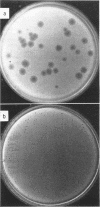Abstract
Watanabe, Tsutomu (Keio University, Tokyo, Japan), Hiroshi Nishida, Chizuko Ogata, Toshihiko Arai, and Sachiko Sato. Episome-mediated transfer of drug resistance in Enterobacteriaceae. VII. Two types of naturally occurring R factors. J. Bacteriol. 88:716–726. 1964.—Naturally occurring R factors are classified into two types, fi+ and fi−, depending on their fi characters. The term fi is an abbreviation of fertility inhibition and fi− and fi− mean, respectively, the presence and absence of suppression of the functions of the sex factor F of Escherichia coli K-12. It was found that fi− R factors reduce the efficiency of plating of phages λ and T1 in K-12; fi+ R factors did not have this inhibitory action. One of the fi− R factors reduced the efficiency of plating of phage T7 as well. Phages λ and T1 underwent host-induced modifications in the host carrying some fi− R factors. At least two types of fi− R factors were recognized by the types of their restriction and host-induced modification of these phages. CaCl2 exhibited antagonistic actions against the restrictions of phages λ and T1 by fi− R factors. Transduction of the ability to ferment galactose with HFT lysates of λ was reduced by fi− R factors. Ultraviolet induction of λ was not affected by any R factors. Furthermore, adsorption of phages λ and T1 was not altered by the presence of any R factors. From these results, we concluded that the suppression of progeny formation of these phages by fi− R factors is due to some step(s) after adsorption of the phages to the bacteria. Superinfection immunity and mutual exclusion were found between two different fi+ R factors but not between fi+ and fi− R factors. The two different fi− R factors were frequently genetically recombined. but fi+ and fi− R factors were not genetically recombined, as indicated by findings of independent transfer of these R factors by conjugation and by transduction from the donors having these two R factors. It was assumed from these findings that fi+ and fi− R factors are considerably different episomes having different resistance-transfer factors.
Full text
PDF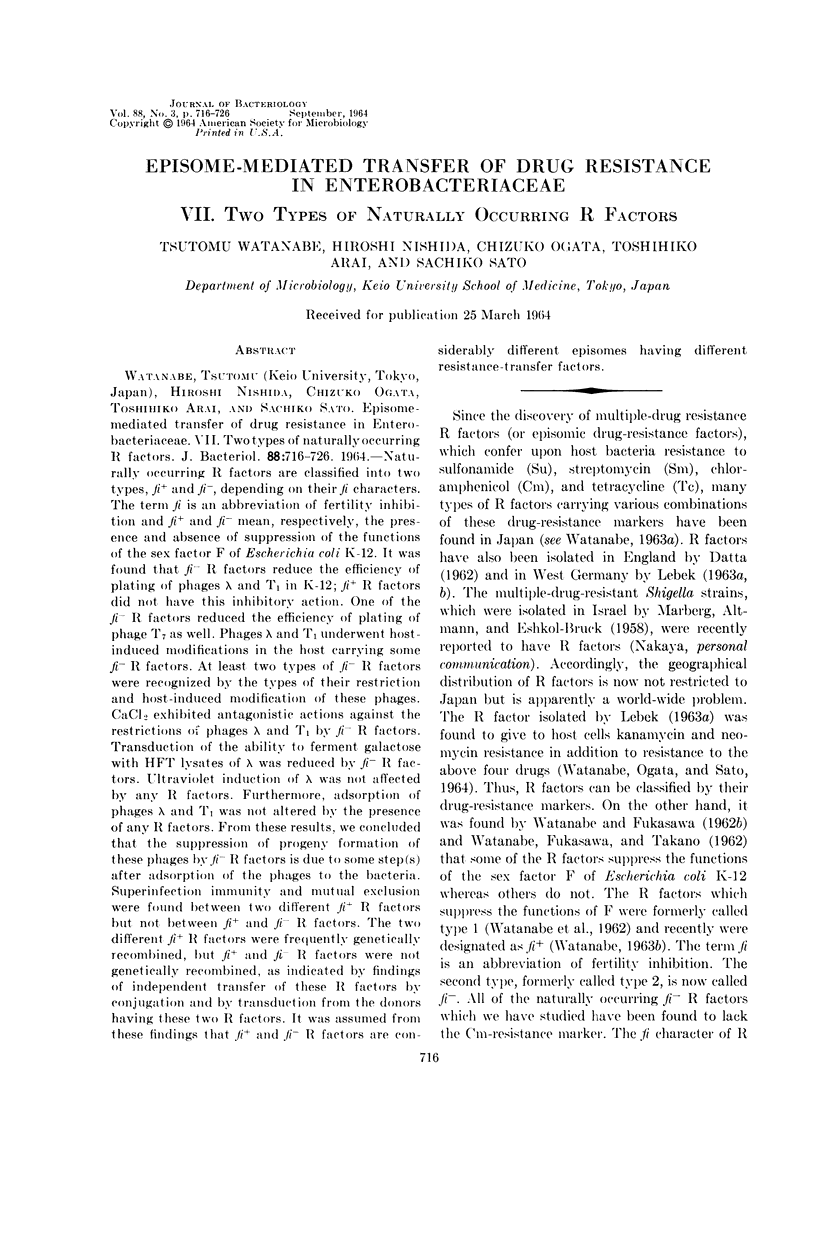
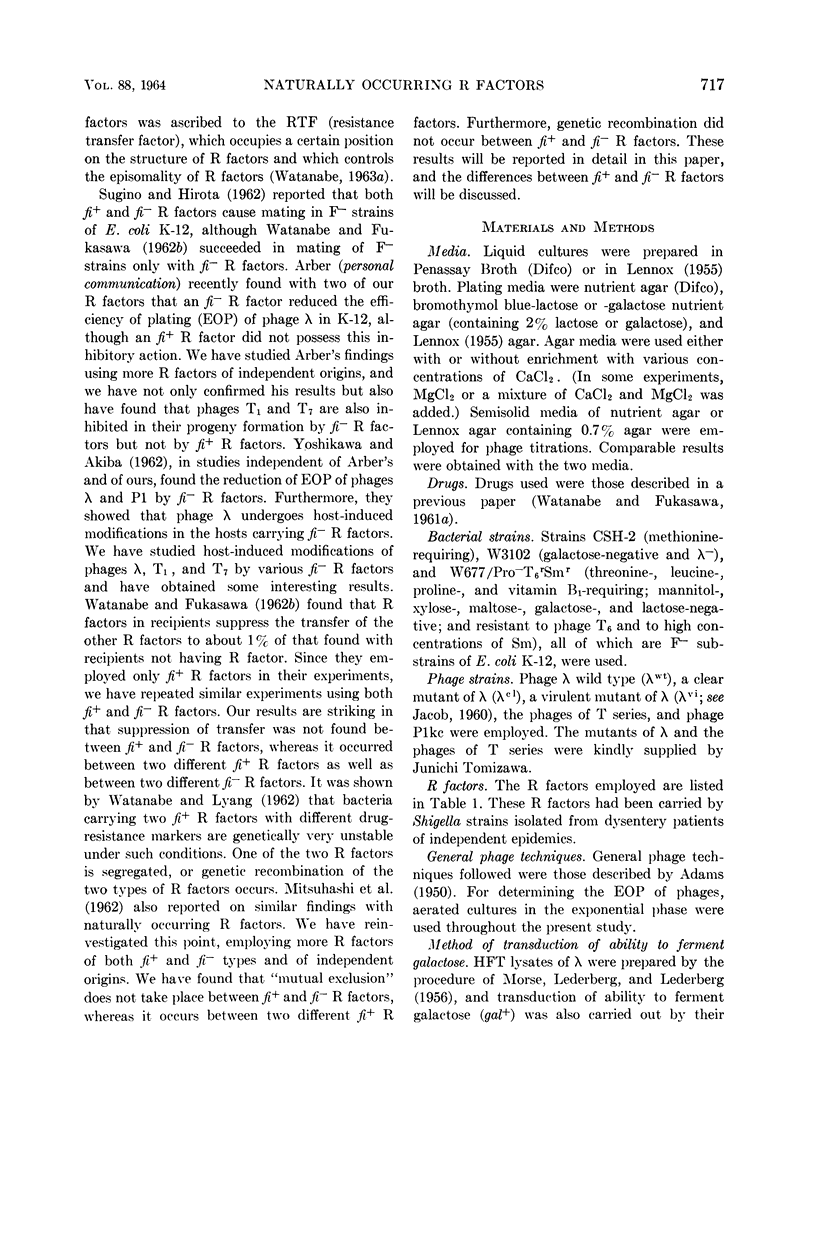
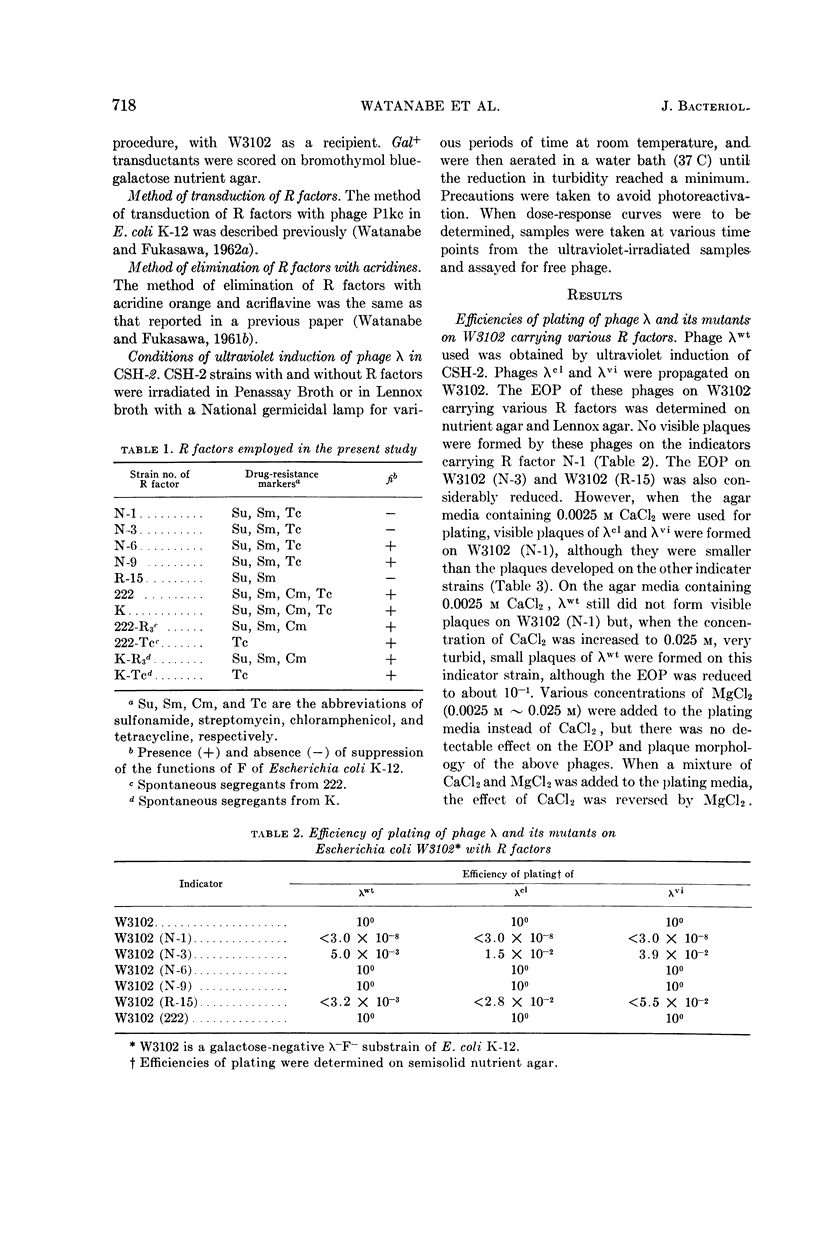
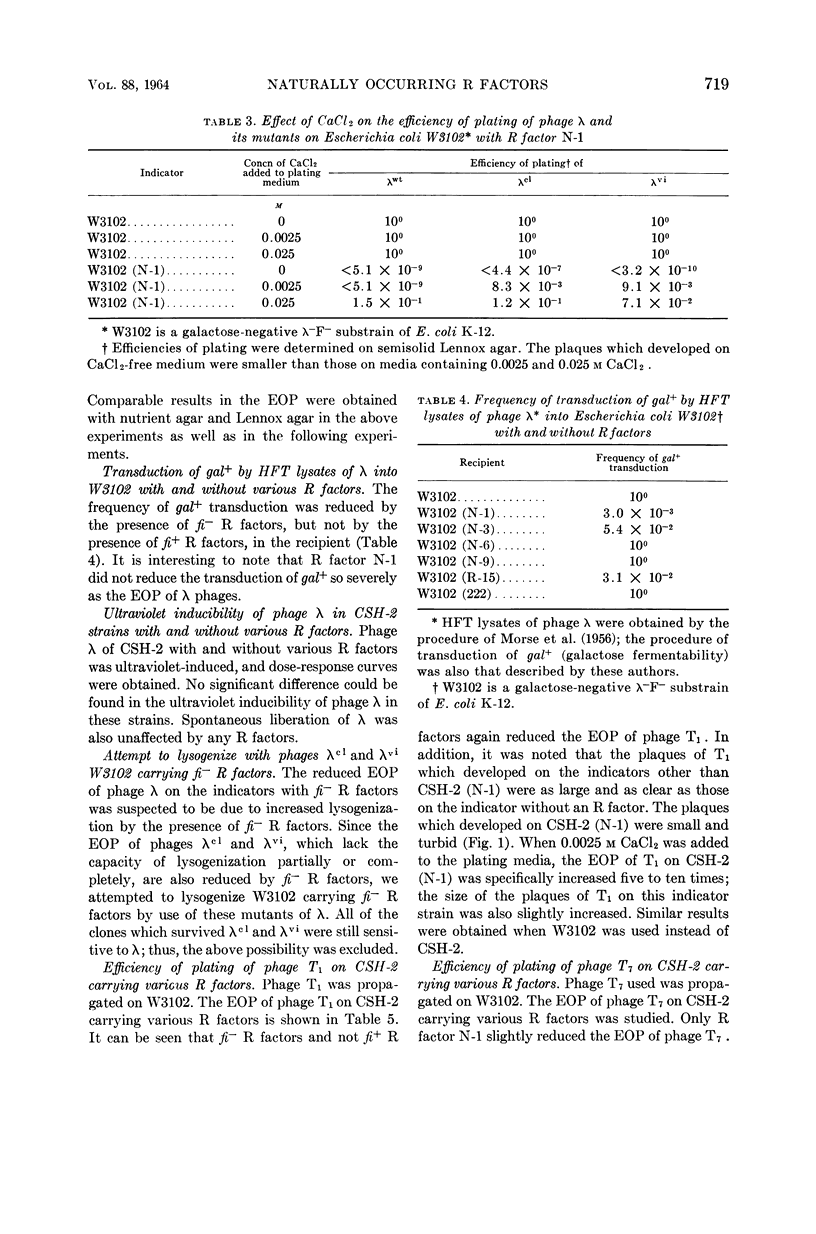
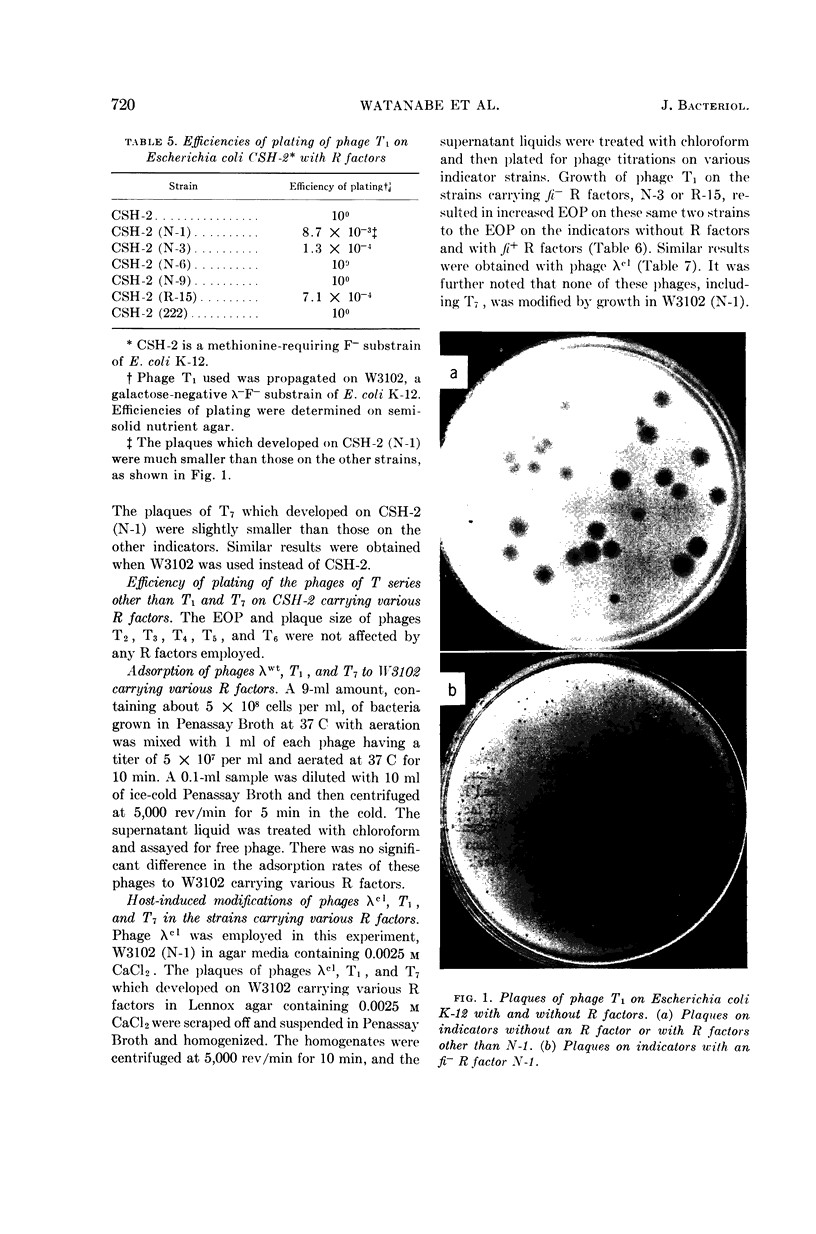
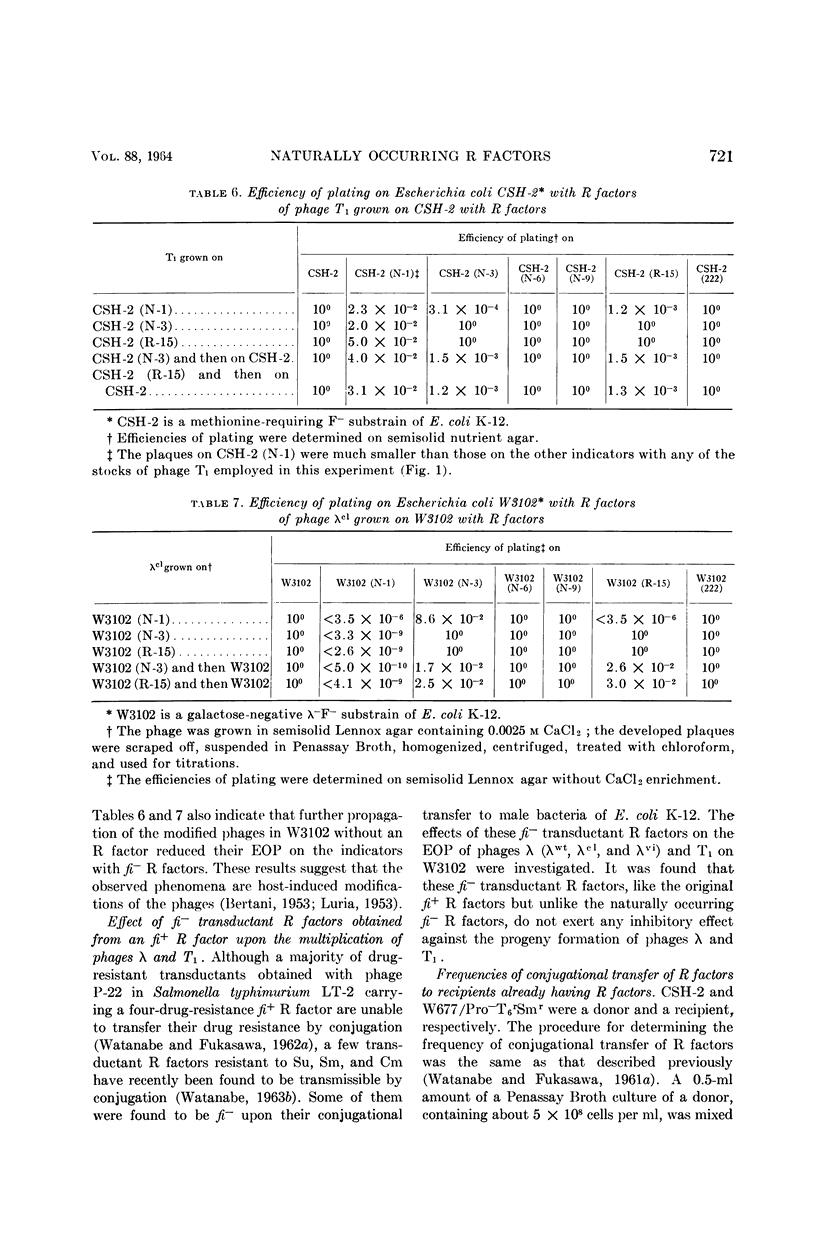
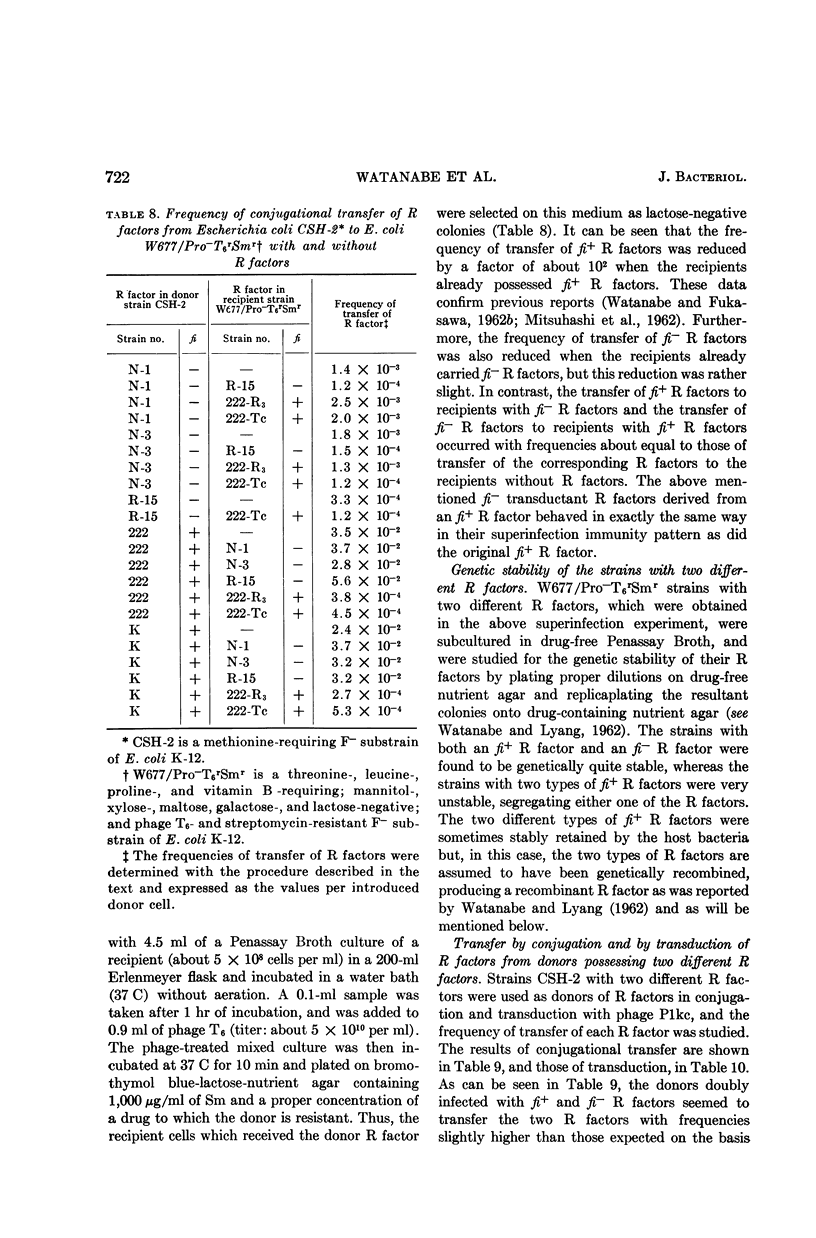
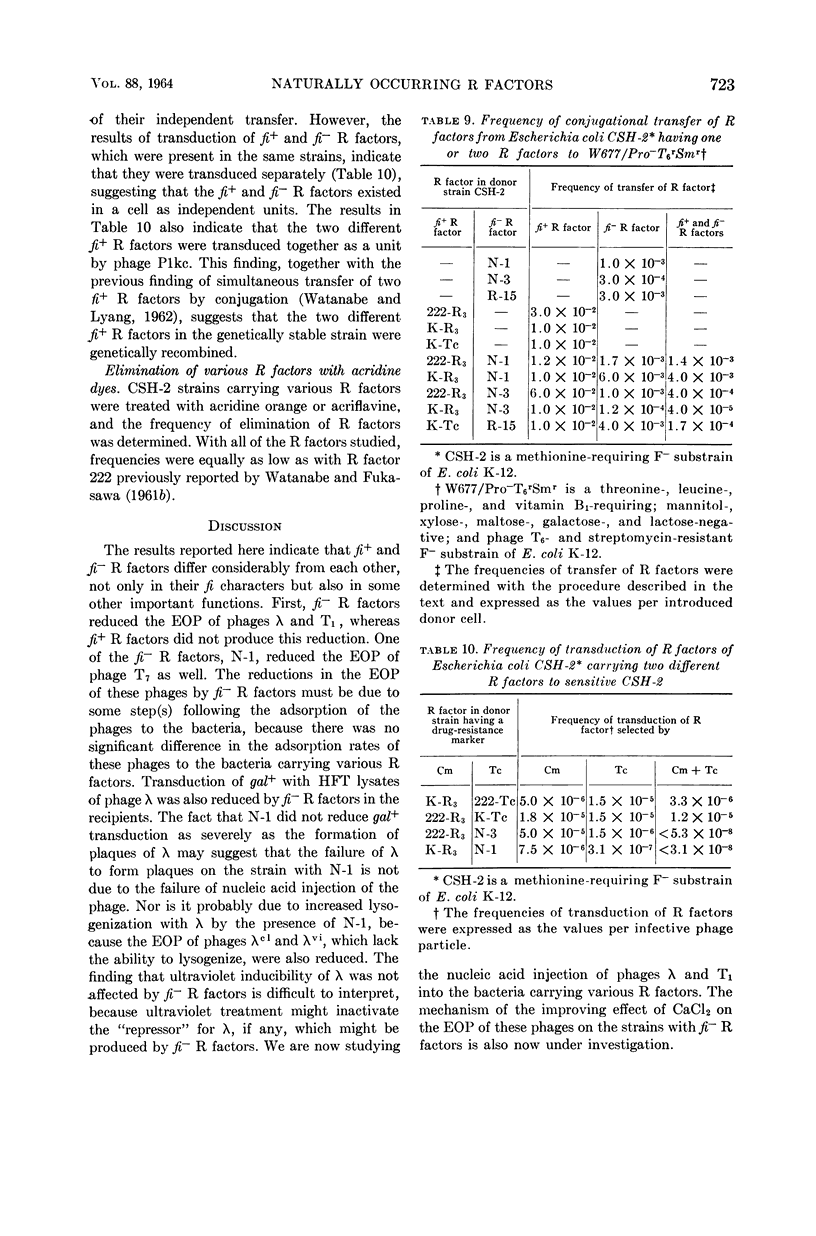
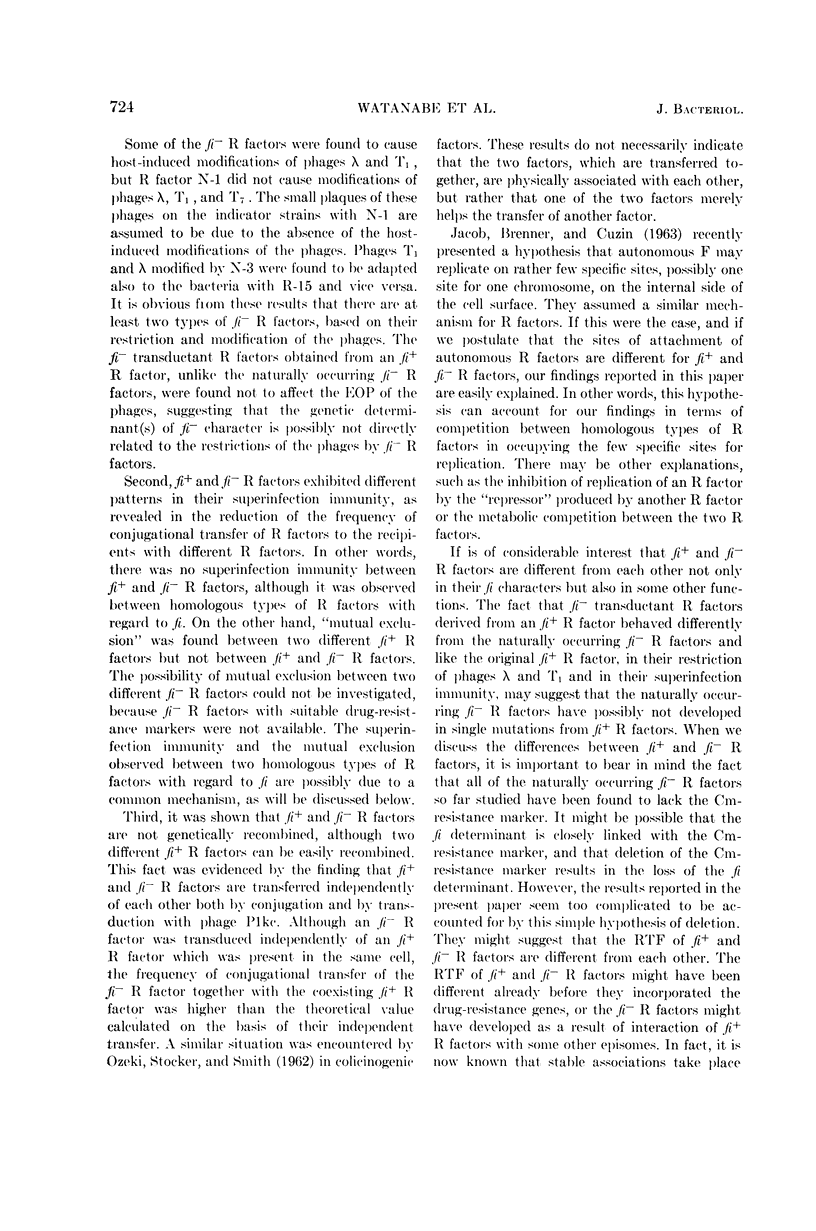
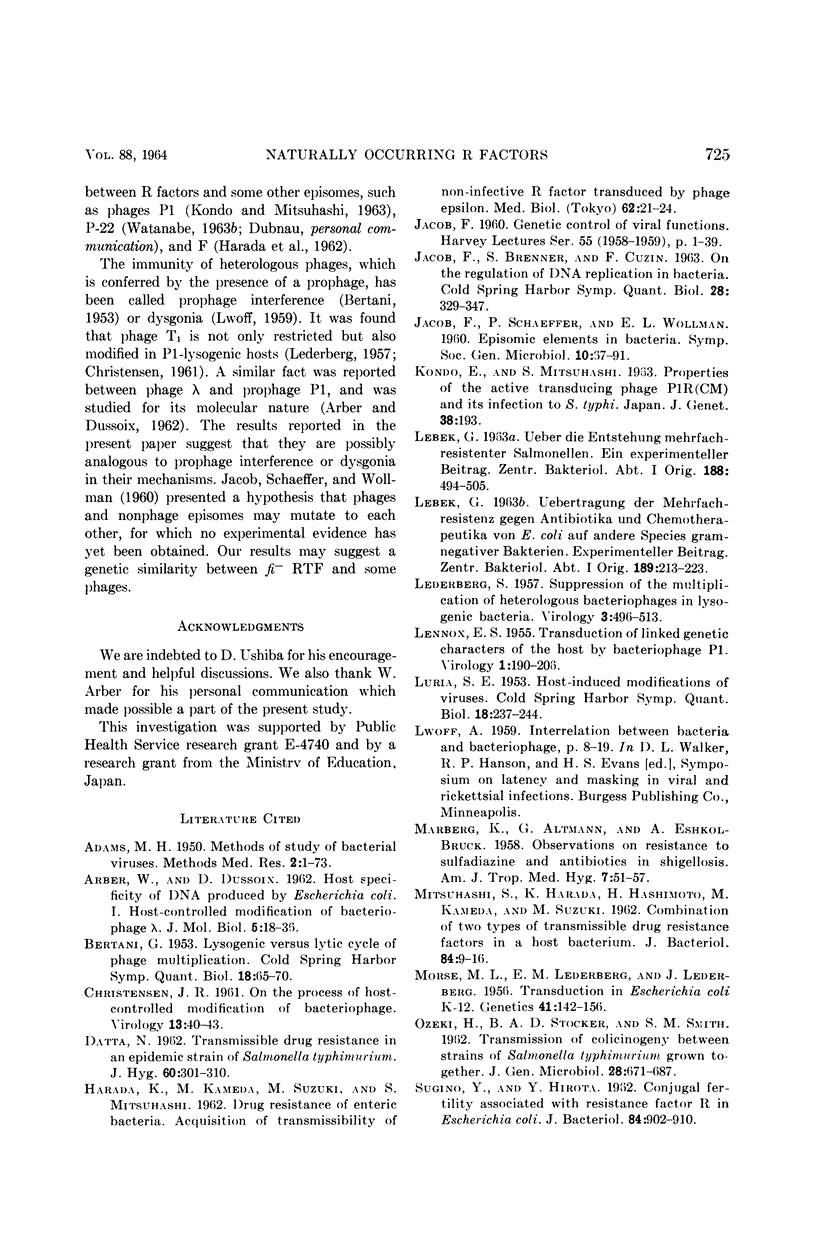
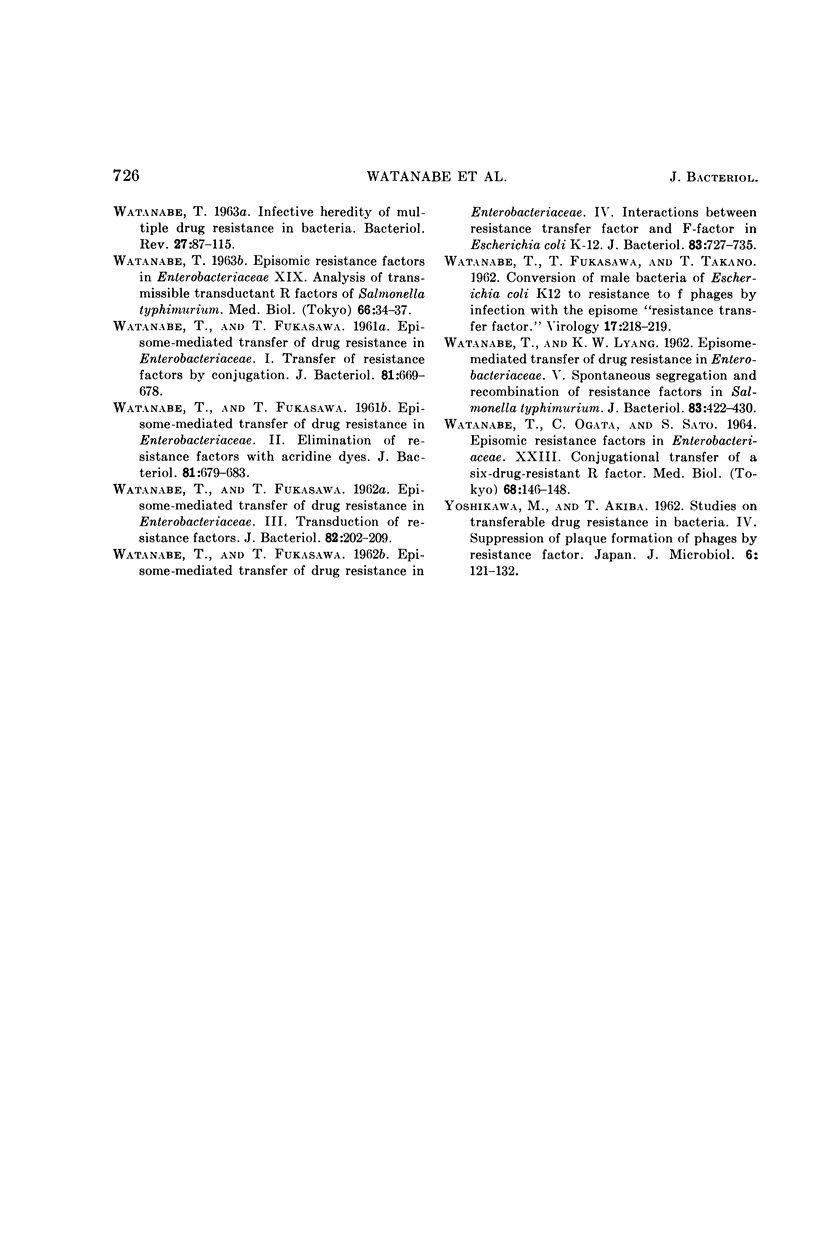
Images in this article
Selected References
These references are in PubMed. This may not be the complete list of references from this article.
- BERTANI G. Lysogenic versus lytic cycle of phage multiplication. Cold Spring Harb Symp Quant Biol. 1953;18:65–70. doi: 10.1101/sqb.1953.018.01.014. [DOI] [PubMed] [Google Scholar]
- CHRISTENSEN J. R. On the process of host-controlled modification of bacteriophage. Virology. 1961 Jan;13:40–43. doi: 10.1016/0042-6822(61)90029-0. [DOI] [PubMed] [Google Scholar]
- DATTA N. Transmissible drug resistance in an epidemic strain of Salmonella typhimurium. J Hyg (Lond) 1962 Sep;60:301–310. doi: 10.1017/s0022172400020416. [DOI] [PMC free article] [PubMed] [Google Scholar]
- LEDERBERG S. Suppression of the multiplication of heterologous bacteriophages in lysogenic bacteria. Virology. 1957 Jun;3(3):496–513. doi: 10.1016/0042-6822(57)90006-5. [DOI] [PubMed] [Google Scholar]
- LENNOX E. S. Transduction of linked genetic characters of the host by bacteriophage P1. Virology. 1955 Jul;1(2):190–206. doi: 10.1016/0042-6822(55)90016-7. [DOI] [PubMed] [Google Scholar]
- LURIA S. E. Host-induced modifications of viruses. Cold Spring Harb Symp Quant Biol. 1953;18:237–244. doi: 10.1101/sqb.1953.018.01.034. [DOI] [PubMed] [Google Scholar]
- MITSUHASHI S., HARADA K., HASHIMOTO H., KAMEDA M., SUZUKI M. Combination of two types of transmissible drug-resistance factors in a host bacterium. J Bacteriol. 1962 Jul;84:9–16. doi: 10.1128/jb.84.1.9-16.1962. [DOI] [PMC free article] [PubMed] [Google Scholar]
- Morse M L, Lederberg E M, Lederberg J. Transduction in Escherichia Coli K-12. Genetics. 1956 Jan;41(1):142–156. doi: 10.1093/genetics/41.1.142. [DOI] [PMC free article] [PubMed] [Google Scholar]
- SUGINO Y., HIROTA Y. Conjugal fertility associated with resistance factor R in Escherichia coli. J Bacteriol. 1962 Nov;84:902–910. doi: 10.1128/jb.84.5.902-910.1962. [DOI] [PMC free article] [PubMed] [Google Scholar]
- WATANABE T., FUKASAWA T. Episome-mediated transfer of drug resistance in Enterobacteriaceae IV. Interactions between resistance transfer factor and F-factor in Escherichia coli K-12. J Bacteriol. 1962 Apr;83:727–735. doi: 10.1128/jb.83.4.727-735.1962. [DOI] [PMC free article] [PubMed] [Google Scholar]
- WATANABE T., FUKASAWA T. Episome-mediated transfer of drug resistance in Enterobacteriaceae. I. Transfer of resistance factors by conjugation. J Bacteriol. 1961 May;81:669–678. doi: 10.1128/jb.81.5.669-678.1961. [DOI] [PMC free article] [PubMed] [Google Scholar]
- WATANABE T., FUKASAWA T. Episome-mediated transfer of drug resistance in Enterobacteriaceae. II. Elimination of resistance factors with acridine dyes. J Bacteriol. 1961 May;81:679–683. doi: 10.1128/jb.81.5.679-683.1961. [DOI] [PMC free article] [PubMed] [Google Scholar]
- WATANABE T., FUKASAWA T. Episome-mediated transfer of drug resistance in Enterobacteriaceae. III. Transduotion of resistance factors. J Bacteriol. 1961 Aug;82:202–209. doi: 10.1128/jb.82.2.202-209.1961. [DOI] [PMC free article] [PubMed] [Google Scholar]
- WATANABE T., FUKASAWA T., TAKANO T. Conversion of male bacteria of Escherichia coli K12 to resistance to f phages by infection with the episome "resistance transfer factor". Virology. 1962 May;17:217–219. doi: 10.1016/0042-6822(62)90108-3. [DOI] [PubMed] [Google Scholar]
- WATANABE T. Infective heredity of multiple drug resistance in bacteria. Bacteriol Rev. 1963 Mar;27:87–115. doi: 10.1128/br.27.1.87-115.1963. [DOI] [PMC free article] [PubMed] [Google Scholar]
- WATANABE T., LYANG K. W. Episome-mediated transfer of drug resistance in Enterobacteriaceae. V. Spontaneous segregation and recombination of resistance factors in Salmonella typhimurium. J Bacteriol. 1962 Sep;84:422–430. doi: 10.1128/jb.84.3.422-430.1962. [DOI] [PMC free article] [PubMed] [Google Scholar]



